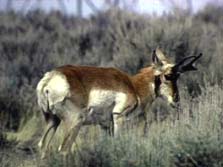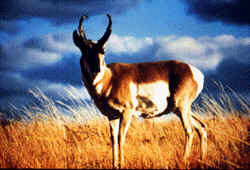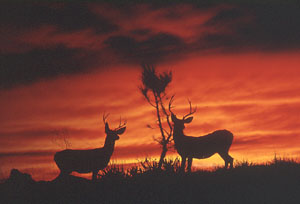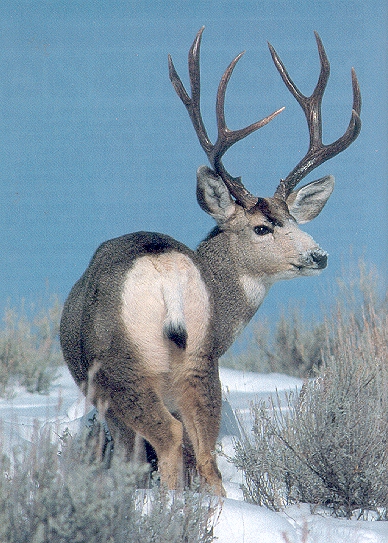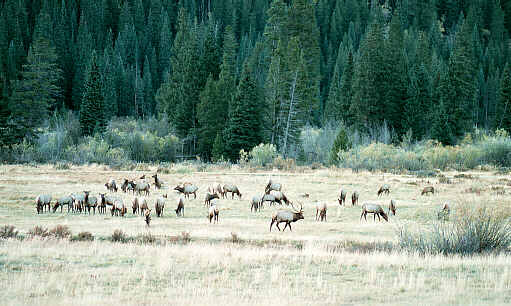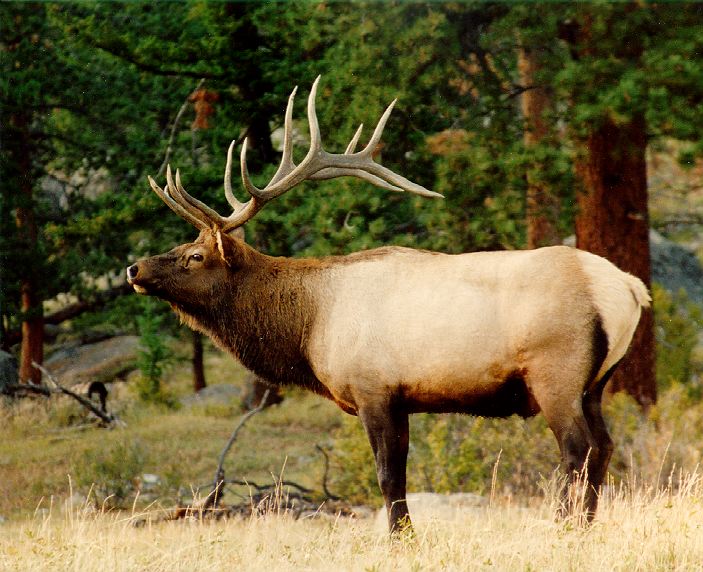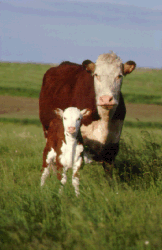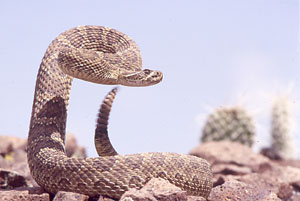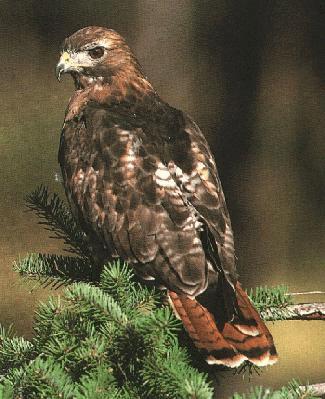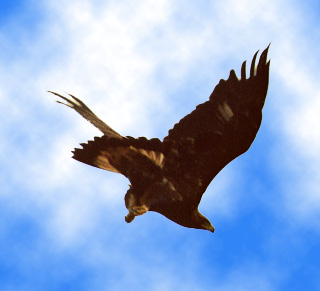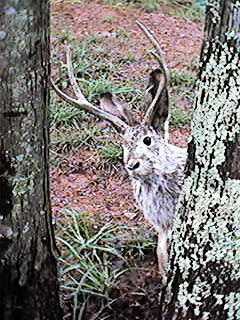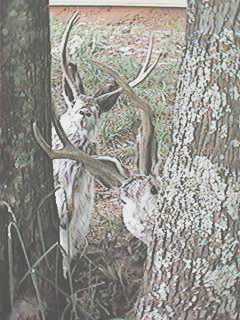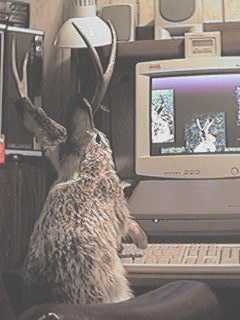
God surely smiled when He made Wyoming! And, He blessed Carbon County with all He had intended for Creation.. Majestic Mountains, beautiful deserts, clear pure water, clear blue skies, so many different types of plants and trees, flora and fauna.
And in His scheme of things, he blessed Carbon County with a multitude of wildlife...too many to even attempt to list here, and so I present to you on this page a small sampling of what you might reasonably expect to see as you traverse the majestic land of this County! Enjoy! By the way..POSTED: NO HUNTING!!..hehehehe

Let us begin our look at Carbon County wildlife with the Pronghorn Antelope. It is not only a reasonable expectation to see this majestic animal as you travel Carbon County, it is almost a guarantee! Carbon County is home to the world's largest Pronghorn Antelope herd. These animals can be see from any roadway in Carbon County, racing across the prairies at speeds of up to 60 miles per hour. Then can run very long distances maintaining speeds of 40 to 50 mph! They are shy, but curious animals..until the first shot of hunting season rings out! They will often allow you to approach them within 100 yards, or closer, if not spooked! I have seen my son on the Red Desert near Rawlins come within 50 yards or so of a buck antelope that kept a weary eye on his every movement, until he got just a little too close for his comfort, and he took to the prairies in a cloud of dust!
|
Pronghorn Antelope Buck feeding on sage brush
|
Silhouetted against an angry sky, this buck keeps a weary eye out for danger
Antelope bucks migrate apart from the does and roam the prairies alone, forming "bachelor" herds. They rejoin with the does when the "rut" begins and mating season approaches.

A little less conspicuous, and even more weary is the Mule Deer. These animals can be seen along the roadways in Carbon County, but will avoid human contact if possible. They prefer the higher elevations, and try to remain as obscure as possible. They are called "mule" deer, because their ears are long, like that of a mule. A graceful animal, they "leap" as they run, bouncing across an open field, jumping up to 6 foot fences with relative ease. Bucks like to remain away from does...unless, of course, it is mating season, and they tend to isolate and stay alone, marking their territories with urine, and with the rubbing off of the velvet that covers their antlers in the Spring and Summer. A good sized buck can tip the scales at over 300 pounds, and with their antlers and sharp pointed hooves, they have a formidable set of weapons with which to defend themselves against any predator. Their favorite line of defense, however, is flight rather than fight...unless they are challenging another buck for mating rights to a herd of does.
|
Two Mule Deer Bucks against a Wyoming Sunset
Mule Deer bucks shed their antlers each year, and in the Spring and Summer, begin the growth of new antlers. The antlers, while growing, are covered in "velvet", and towards the end of the summer, the bucks begin rubbing against trees and rocks to rid themselves of the velvet that has grown over the last couple of months. A mule deer's antlers will be the color of the tree or shrub he has used to shed that year.
|
A Nice sized Muley Buck Surveys the Situation

The North American Wapiti or Elk, is a majestic creature indeed! Traversing through Carbon County along the Snow Chi Mihn Trail (I-80), every once in awhile, you may spot an elk or two. More commonly sticking to the higher elevations of the Mountains, these animals are splendid specimens of wildlife. A member of the deer family, they band together in herds, with a Bull Elk in charge. Come the Fall, and mating season, the Bulls get agitated and anxious, and begin "bugling" their challenges to other Bulls in the area to come out and fight for control of a herd and mating rights. Click here to listen to a Bull Elk bugling in the forest! The sound of these Bulls in the rut fills the Autumn air in the Mountains, and is a sound to behold! Be assured, if you hear that, you are in close proximity to a Bull Elk with an attitude! Beware! They WILL charge you!!
|
A herd of Elk with a nice Bull in Control

Hehehehe...I promised myself I would be nice in these pages, but I just can't resist....you see, for a long time I hunted these majestic animals, and got shot at a time or two...not a fun experience...sheesh..the last time I checked, I didn't have any antlers...hehehe...So, a quick hunting lesson for you Flatlanders: Below...is a Bull Elk. Burn it into your memory, study the size and shape, go back and listen to what one sounds like....and PLEASE don't shoot anything that goes "moo", or you are going to have an irate rancher on your hands!! hehehehe
|
This is a Wyoming Bull Elk....
|
This is a Nebraska Elk..heheheh
Click to hear a herd of Nebraska Elk

Wyoming's Wildlife, and that of Carbon County is varied and plentiful indeed. But not all animals are fun to look at or hunt. Some are downright dangerous! During the Summer months, the prairies on the Red Desert are home to one of the West's most dangerous critters...the Prairie Rattlesnake. Blending in with the sage brush and the rocks it calls home, occupying empty Prairie Dog towns or gopher holes, or anyplace it can find, these creatures are to be respected and approached with extreme caution. They coil in the sun during the day, sunning themselves on top of rocks or even sage brush, and will strike at anything that comes too close if they cannot "escape". If you are out on the desert, and you hear this:Click Here..and Remember This Sound!...stop in your tracks and figure out where the sound is coming from, lest you walk right into him, and be bitten! A Prairie rattler can reach lengths of up to about 6 feet, and can strike half the distance of their body...so that means, if you are within 3 feet, you are in range! (and as far as I am concerned, if you are within 100 feet, you are 99 feet too close!)
|
A Prairie Rattler posed to strike...BEWARE!
Rattle snakes, like all of God's creatures do have a purpose...they keep the rodent population in check, and provide food for birds of prey and other predators...so, I guess even a snake does have some uses....very few...but some, none the less..hehehehhe

Speaking of Birds of Prey, Carbon County is home to a variety of these graceful birds. Skilled hunters, keen eyed, and beautiful to watch soaring on the wind currents above, Carbon County provides nesting grounds for Golden Eagle, Turkey Vultures (well..not all birds are pretty..hehehe), several different types of owls, and the Red Tailed Hawk. If you are not the one behind the wheel of the car, look skyward periodically, and you will spy these birds in flight. Often, you will see hawks and eagles perched on fence posts, eyeing traffic as it whizzes by.
|
A Redtailed Hawk perched on a tree limb
|
A Golden Eagle swooping in for dinner

There are so many different types and forms of wildlife in Carbon County that I could go on and on and on...but I think you get the picture. Carbon County Wyoming is home to God's Creation and Creatures, all living in harmony of how He intended it to be. Also in Carbon County, you can see herds of wild horses roaming the deserts, kicking up dust as they race across the prairies.
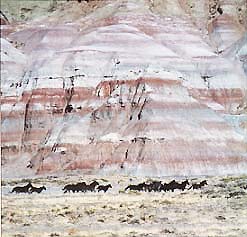
A herd of Wild Horses Running in the Red Desert

And to close this page, if you recall, back on the index page, there was a picture of a Jackalope. These shy, rare animals rarely come out in daylight, and usually stay as far away from man as possible. They have been known to mimic sounds to draw attention away from themselves like passing cars, overheard planes, trains...you name it! They are smart animals, and very secretive in nature. Once in awhile, you can catch one and milk them...Wyoming Jackalope Milk is mmmmmmm mmmmmm good, and good for you too! It relieves arthritis, takes away the sting from insect bites, gives you virility, and has been known to prevent aging and grey hair. You are most likely to see the female of the species during the day, as she scurries across the prairies in search of food. The Female has no antlers, and is therefore more resembling of a rabbit, hence, they call them Jack Rabbits. The Male of the species, however, sports a set of antlers usually resembling deer antlers, but often sporting antlers that look like Pronghorn antlers....they are very rarely seen in the open or during daylight at all!
They are very intelligent creatures, and have been known to enter one's home in the absence of the occupant, and watch TV, read, and even work on computers! They are on the endangered species list, and therefore, it is illegal to hunt, shoot or trap these shy little critters...but who would want to anyway??...I happened to spy a couple recently, and managed to get their pictures, so here they are:
|
|
Here's Looking at YOU kid...we do TOO exist!! Seeing is Believing...Humans...bah!
|
"Hey, Look Joshua....they have YOU on the Computer thing-a-mabobber!"
I hope you have enjoyed your visit to the Wildlife of Carbon County Page! Please be sure to respect all of God's Creatures, and enjoy the sights as you travel our County! Please go back to the Main Page and sign my guestbook, or email me with your suggestions or comments!

Back to Wyoming: Carbon County Facts and Fiction
